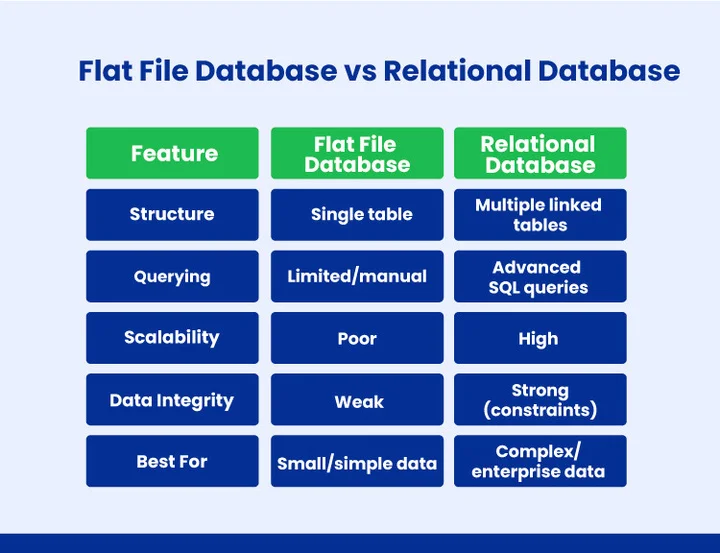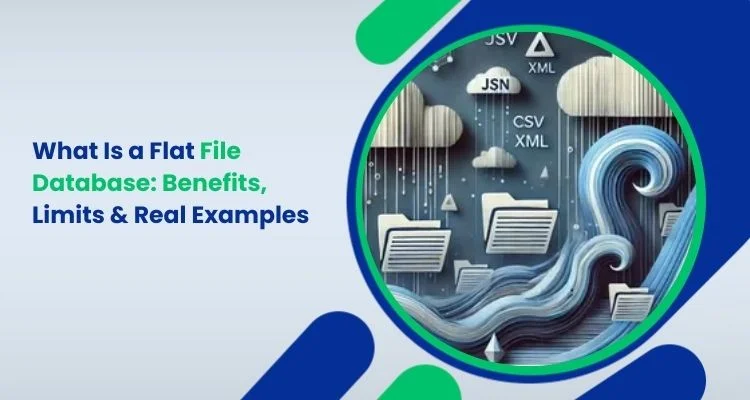Data is at the heart of every application, but not all storage systems are created equal. For decades, organizations relied on simple file-based systems to store and retrieve information. While these databases might seem outdated compared to modern relational or cloud-native systems, they still power critical functions in industries where simplicity and speed matter.
In fact, a recent industry survey found that approximately 60% of organizations using flat file architectures reported significantly faster data retrieval times, and nearly 70% noted improved processing speeds, underscoring how flat files can deliver real performance gains.
So, should developers and organizations still rely on flat file databases, or are they too limited for modern needs?
Making the best choice requires an understanding of its advantages, disadvantages, and practical uses. After all, choosing the wrong database type can lead to performance bottlenecks, security risks, and higher costs in the long run.
In this blog, we will explore what a flat file database is, its benefits, limitations, and real-world examples.
Let’s start with the flat file database definition!
What is a Flat File Database?
A flat file database is the simplest form of database, storing information in a plain text file with one record per line. Each record contains fields separated by a delimiter, such as commas, tabs, or spaces. Unlike relational databases, flat file databases don’t use multiple linked tables because they function as a single table where all data is kept together.
Flat files are often saved in formats like CSV (Comma-Separated Values), TSV (Tab-Separated Values), JSON, or XML. These formats make them easy to read, write, and transfer between systems. For this reason, they are still widely used for data exchange, system configuration files, and lightweight storage needs.
Table of Contents
What is a Flat File Used For?
Flat file databases are simple, single-table systems that are easy to use and widely compatible. They serve as a lightweight solution when complex database structures aren’t needed.
- Log Files: Capture system or application logs in plain text for easy review.
- Configuration Settings: store software or server configuration details in a simple, readable format.
- Data Exchange: transfer information efficiently via CSV, TSV, JSON, or XML files.
- Lightweight Storage: manage small datasets quickly without requiring a full database system.
- Import/Export: move data seamlessly between applications or platforms.
While flat files are excellent for small, straightforward datasets, they are less suitable for large-scale or complex data. As data requirements grow, organizations often migrate to relational or NoSQL databases to gain better scalability, structure, and querying capabilities.
This structure makes flat file databases ideal for smaller datasets or scenarios where speed and simplicity matter more than advanced querying or relationships. However, as data becomes increasingly complex, organizations often shift toward relational or NoSQL databases for improved scalability.
Understanding the differences between flat file databases vs. relational databases is essential for choosing the right storage system, especially as data complexity and scalability needs grow.

Choosing between flat file and relational databases?
What are the Advantages of the Flat File Databases Model?
Although flat file databases are considered simpler than relational or NoSQL systems, they continue to deliver practical, real-world advantages.
Here are the key benefits explained in detail:
1. Simplicity And Ease Of Use
Flat file databases are incredibly straightforward to set up and maintain. They require no database management systems, just a text editor, spreadsheet application, or basic scripting. This accessibility makes them ideal for rapid deployment in small-scale or temporary projects.
2. Lightweight And Fast
With data stored in a single, unindexed file, flat files often outperform complex systems when handling small to moderate datasets. As the survey shows, organizations frequently experience noticeably faster retrieval and processing times.
3. High Portability
Flat file formats like CSV, TSV, and JSON are universally accepted across applications, platforms, and languages. A CSV file, for instance, can be opened in Microsoft Excel, imported into SQL databases, or parsed by Python, making it perfect for cross-system data exchange.
4. Low Resource Requirements
Without the need for database servers or dedicated infrastructure, flat file databases run with minimal overhead. They’re particularly suited for embedded systems, lightweight apps, or environments with constrained hardware resources.
5. Ideal For Quick Data Exchange
Flat files remain the go-to choice for data migration, system integration, and API-based transfers. They don’t require complex conversions or adapters, enabling smooth and reliable data interchange across diverse systems.
6. Transparency And Human-Readability
Because the data is stored in plain text, flat files are easy to inspect, debug, and manually edit. This transparency simplifies troubleshooting and supports quick corrections without specialized query tools.
Which Limitations Do Flat File Databases Have?
While flat file databases offer simplicity and speed for small-scale use, they also come with significant drawbacks that limit their effectiveness in modern, data-intensive environments. These limitations become more visible as datasets grow larger and business needs become more complex.
1. Data Redundancy and Inconsistency
Because flat files store all information in a single table, duplicate records are common. For example, if customer details are repeated across multiple records, updating one entry won’t automatically update the others. This leads to inconsistent and unreliable data over time.
2. Lack of Relationships
Unlike relational databases, flat file structures cannot create connections between different sets of data. Everything exists in one “flat” structure, which makes it difficult to model real-world relationships such as orders linked to customers or employees linked to departments.
3. Poor Scalability
Flat file databases perform well with small datasets, but as the volume of data grows, performance declines. According to a Dataversity report, flat files become increasingly inefficient for large-scale storage because they lack indexing and optimization features.
4. Limited Querying and Flexibility
Advanced queries, filtering, and data manipulation are either slow or impossible in flat file systems. Users often have to write custom scripts or manually scan files, which can be time-consuming compared to SQL queries in relational databases.
5. Security Risks
Since data is usually stored in plain text, flat file databases are vulnerable to unauthorized access and tampering. Without built-in encryption or access controls, sensitive information like passwords or personal data can be easily exposed.
6. Maintenance Challenges
As datasets expand, managing, editing, and ensuring accuracy in a flat file database becomes cumbersome. Simple tasks like updating a record or fixing an error can require scanning through thousands of lines, increasing the risk of mistakes.
What Are Real Examples of Flat File Databases?
Flat file databases are simple, single-table systems that store data in plain text. They are easy to create, read, and transfer between systems. Here are the top 3 practical examples:
Example 01: CSV File for Contacts
A CSV (Comma-Separated Values) file is one of the most common types of flat file databases. It stores data in plain text, with each line representing a record and each field separated by a comma.
Sample CSV:
FirstName,LastName,Email,PhoneNumber John,Doe,johndoe@example.com,555-1234 Jane,Smith,janesmith@example.com,555-5678 Alex,Johnson,alexjohnson@example.com,555-9012
Explanation:
This simple CSV illustrates how flat files organize and store data:
- Header row: The first row defines the column names, FirstName, LastName, Email, and PhoneNumber.
- Records: Each subsequent line is a record containing the relevant data for one person.
- Fields separated by commas: Ensures each piece of information is clearly divided.
- Easy to access: Can be opened, edited, and managed using Excel, Google Sheets, or even a text editor.
- Use cases: Ideal for small datasets, quick edits, and data exchange between systems without the need for complex database software.
Summary
This example shows how flat files provide a simple, clear, and portable way to store and manage data. Whether for contact lists, logs, or configuration files, flat files remain a practical solution when simplicity and accessibility matter more than advanced database features.
Example 02: JSON Configuration File
JSON (JavaScript Object Notation) is another flat file format widely used to store configuration data, especially in software and web applications.
Sample JSON:
{
"server": "localhost",
"port": 8080,
"mode": "development"
}
Explanation:
This JSON file stores server settings in a flat, text-based format. Developers often use JSON for:
- Application or server configuration files
- API responses and data exchange
- Lightweight storage where readability and portability matter
Frequently Asked Questions (FAQs)
2. What’s the Difference Between a Flat File Database and a Relational Database?
Flat File Database: Stores data in a single table, easy to create and manage, suitable for small datasets. Limited querying capabilities and not ideal for large or complex data.
Relational Database: Uses multiple linked tables, supports advanced queries, ensures data integrity, and scales well for large datasets. Better for complex relationships and enterprise-level applications.
3. What Are the Main Advantages of Flat File Databases?
The main advantages are as follows:
- Simple to create and use without specialized software.
- Lightweight and fast for small datasets.
- Highly portable across systems and platforms.
- Easy to read, edit, and share using common tools like Excel, Google Sheets, or text editors.
Conclusion
Flat file databases offer a simple, fast, and portable way to manage small datasets, making them ideal for logs, configuration files, contact lists, and quick data exchanges. Their ease of use and minimal resource requirements make them particularly valuable for lightweight applications or temporary projects.
However, as data grows more complex and applications scale, flat files alone may struggle with performance, querying, and maintenance.
When evaluating flat file databases vs. relational databases, it becomes clear that combining flat files with more structured systems can significantly improve efficiency, consistency, and security. In such scenarios, Cloud Engineering Service handles these challenges effectively.
Developers and companies can choose when to use flat file databases and when to switch to more sophisticated storage options by being aware of the advantages and disadvantages of these systems.
This will help to ensure that their applications continue to be scalable, dependable, and performance-optimized.
Need help choosing the right database for your project?








Share your thoughts about this blog!